Alimul Haque Khan1, Asif Islam2, Maidul Islam1, Tabassum E. Nur1, Sanchita Ghose1
1Electrical & Electronic Engineering, Bangladesh University of Engineering & Technology (BUET), Dhaka, Bangladesh
2Information Technology & Electrical Engineering, The University of Queensland (UQ), Brisbane, Australia
Correspondence to: Alimul Haque Khan, Electrical & Electronic Engineering, Bangladesh University of Engineering & Technology (BUET), Dhaka, Bangladesh.
| Email: |  |
Copyright © 2015 Scientific & Academic Publishing. All Rights Reserved.
Abstract
This paper describes the available topologies for electricity generation and its evacuation system in Bangladesh. Usually, electricity is generated in a large power station and it is then sent to the customer end by means of transmission and distribution system. This is an established technology. However, this system proves very costly and the cost increases especially when the service area is remote. In remote areas, local people use kerosene as a fuel for lighting. Also, diesel generators for electrifying local markets and villages are being used. However, these generators run for a few hours of the day and the generation cost becomes very high. Practice of battery charging based electricity system is also found in many places of the remote area. Besides these, Government of Bangladesh (GOB) is trying to electrify the remote areas by means of SHS, which has been being used to replace the traditional kerosene-based lamps from 1998 in Bangladesh. However, with the advancement of technology, the demand of present SHS consumers is increasing considerably. Electricity to all is an essential requirement for the proper development of Bangladesh. Thus, it is essential to supply power with quality and reliability to the present users of the national grid, customers of the SHS and people of the un-electrified region. With this context, possibilities of exploring new topologies of generation and evacuation have also been discussed in this paper.
Keywords:
Micro-Grid, Renewable Energy Penetration, Distributed Energy Resources, Load Management
Cite this paper: Alimul Haque Khan, Asif Islam, Maidul Islam, Tabassum E. Nur, Sanchita Ghose, A Review on Electricity Generation and Evacuation in Bangladesh, Energy and Power, Vol. 5 No. 1, 2015, pp. 10-16. doi: 10.5923/j.ep.20150501.02.
1. Introduction
Producing electrical power by means of any energy conversion method is known as electricity generation. Electricity is basically produced from rotary machines such as gas turbine, steam turbine, hydro-turbine and engines etc. The necessary systems that are needed to transfer power from the generating unit to the customer end are known as the evacuation system. Bangladesh is a small country with large amount of population. Presently, 55% [1] of the total population has access to electricity and per capita generation is 321KWh [2] which is very low compared to other developing countries. There are mainly three major methods or topologies (Figure 1) of supplying electricity to the customers in Bangladesh. The first one is the traditional large-scale centralized generation, where electricity is generated from hydroelectric power plants, gas turbines, steam turbines, gas engines and diesel engines and by many other means. In a hydroelectric power plant, potential energy of the reserved water is converted into electrical energy. The cost involvement is only for operation and maintenance. On the other hand, Steam Turbines (STs), Gas Turbines (GTs) or engine generators are based on fuel such as natural gas, High Speed Diesel (HSD), Furnace Oil (FO), Coal etc. The concerned authority of the Government of Bangladesh, Bangladesh Power Development Board (BPDB) is generating power by its own generators as well as by purchasing electricity from other private companies [2-5]. Whoever produces the electricity is then transmitted and distributed to the consumer end by means of the available transmission and distribution (T&D) system. The T&D system needs special infrastructure, which is very costly [6-7].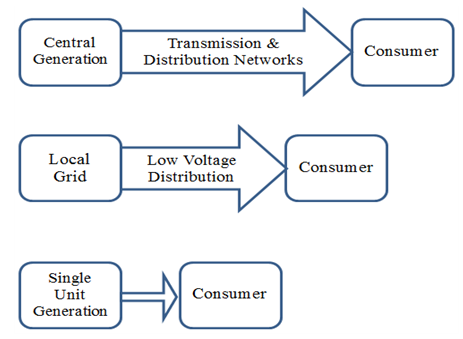 | Figure 1. Three topologies of generation and evacuation of electricity in Bangladesh |
The second one may be termed as the single unit generation i.e. a standalone system that does not need any T&D system such as the solar home system (SHS), solar irrigation system etc. Along with the centralized generation, till now (October, 2014) more than 3 million (3,258,653) SHSs have already been installed in the off-grid rural areas of Bangladesh under the program run by IDCOL [6], [7] with the co-operation of several Non-Governmental Organizations (NGOs). As a result, more than 13 million beneficiaries are getting solar electricity, which is around 10% of the total population of Bangladesh. Most of the installed SHS units are used at home; few of them are used in educational institutions, prayer houses and shops in the market. A SHS is able to provide electricity for a few light bulbs, small DC fan and TV, rechargeable torch lights and adapters for mobile phone charging.The third method of supplying electricity is the local grids run by small-scale diesel/petrol engines at the remote areas. Unfortunately, this method of supplying electricity has not been taken into consideration by the policy makers and has so far remained neglected. These generation units are distributed all over the remote areas of the country and are not interconnected in any way. The generated energy is locally consumed with a low voltage distribution line. However, generation cost is also high in this case. These are operated by local electricians/operators in most of the cases and thus it has enough risks of electrical hazards. These topologies are shown in the following flow chart. Local grid is shown between the extreme two cases.Till June, 2013 the total generation capacity of the country is 8537 MW (Table 1). Though, 3.11% and 11.95% energy is lost due to transmission and distribution respectively. As far as the fuel is concerned, the generation capacity is 5730 MW by Natural Gas, 1876 MW by Furnace Oil, 511 by Diesel, 220 MW b Hydro and 200 MW by Coal. Total net Energy Generation (Excluding REB) in FY 2013 was 16482GWh in which 77.07% is generated from Natural gas.Table 1. Generation from Different Fuel Sources on FY 2013
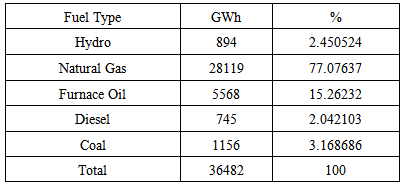 |
| |
|
Energy Flow Chart FY 2013 shows that 77.91GWh of energy is produced from 34.79 Million liter of Diesel costing 30.364BDT per kWh of energy whereas it is 13.46BDT for Furnace oil, 3.7BDT for coal and 0.902BDT for gas based generation on an average(only for BPDB Generation) [1]. As of June 2013, there is almost 3020 km of 230 kV and 6148 km of 132 kV transmission line available in the country. The number of 230/132 kV substation is 16 and combined capacity of those entire substation is 7525 MVA. Besides, there are 103 substation of 132/33 kV available throughout the country with a capacity of 11792 MVA. The distribution network is the biggest of the lot, with 3728 km, 13128 km and 21839 km of 33 kV, 11 kV and 400 V lines respectively. And of course, there are 158 substations of 33/11 kV for distribution of power around the country [3]. 40.10% of the mentioned generated power is purchased by Rural Electrification Board (REB) [8] and distributed to the pastoral area. BPDB distributes 24.64% of the power among the urban consumers. Dhaka Power Distribution Company (DPDC) [9], [10] and Dhaka Electric Supply Company (DESCO) [11], [12] distribute 18.59% and 10.51% of the power among the consumers in Dhaka metropolitan area. Rest 6.17% of the power is distributed by West Zone Power Distribution Company (WZPDC) in Khulna and Barisal division [1]. 46.52% of the power is used for resident loads, 10.34% for commercial purposes, 37.42% for industries, 3.17% for agriculture and 2.56% for other purposes.
2. Power Generation
Most of the power stations in Bangladesh are based on natural gas, which is around 80% of the total capacity on the FY 2013 [1]. On the other hand, gas is short supply and about 1500 MW of generation shortfall occurs in a day due to shortage of gas [2]. Therefore, it will be very tough to provide more electricity generated from the natural gas in future. PGCB daily reports show the decreasing supply of natural gas and more and more penetration of oil-based generation. Government of Bangladesh is trying some alternative to natural gas such as coal, HSD and Furnace oil based power plants under the fuel diversification program [1]. So far, as the fuel is concerned, the generation capacity is 6,719 MW by Natural Gas, 1,963 MW by heavy fuel oil (HFO), 783 MW by high speed diesel (HSD), 230 MW by Hydro and 200 MW by Coal. Besides these, 500MW has been imported from India since November, 2013 via HVDC line. Table 2 shows the installed capacity of Power Plants in Bangladesh [2].Table 2. Installed Capacity of Power Plants in Bangladesh
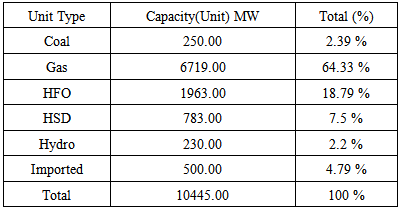 |
| |
|
Presently, the use of natural gas, HSD, Coal and HFO are around 80%, 10%, 5%, and 3% [1], respectively of the total generation. Bulk of the power in Bangladesh is generated by Bangladesh Power Development Board (BPDB). There are other independent power sources as well. Power Division, Ministry of Power, Energy & Mineral Resources (MPEMR), and Bangladesh Energy Regulatory Commission (BERC) are the governing bodies of Power Sector of Bangladesh.The following five authorities are responsible for power generation in Bangladesh:● Bangladesh Power Development Board (BPDB)● Ashuganj Power Station Company Ltd. (APSCL)● Electricity Generation Company of Bangladesh Ltd. (EGCB)● North West Power Generation Company Ltd. (NWPGCL)● Independent Power Producers (IPPs)Table 3 shows the de-rated generation capacity and their market share for the five authorities of electricity generation [8].Table 3. Various Authorities, Capacity and Their Market Share
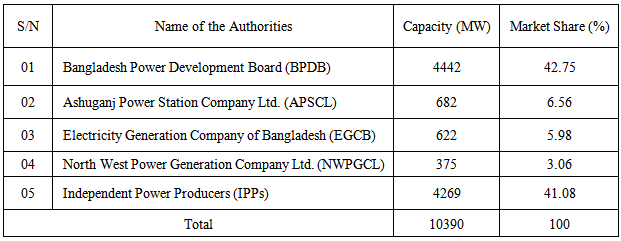 |
| |
|
All the generated power are purchased by the BPDB and then transmitted by the Power Grid Company Bangladesh (PGCB) to the customers’ premises. The generation cost and purchase cost of each unit (KWh) of electricity is shown in Table 4 above [3-5].Table 4. Average and Maximum Cost of Generation and Purchase by Different Types of Power plant
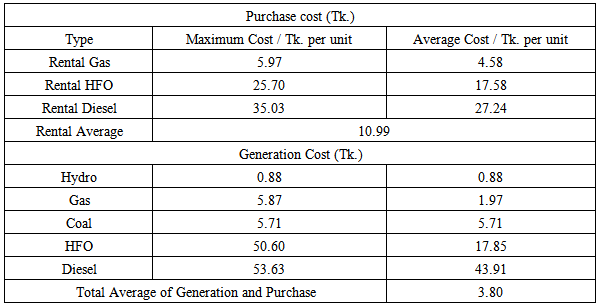 |
| |
|
Till September, 2014 the total generation capacity of Bangladesh is 10,445 MW the de-rated capacity is 10,390 [2]. It should be noted here that 3.11% and 11.95% of energy generated are lost due to transmission and distribution, respectively.The major part of the generation comes from the natural gas, for which the cost of generation of per unit energy is lower. However, it is higher for HSD and HFO due to high price. Energy Flow Chart of FY 2013 [6] shows that 77.91 GWh of energy is produced from 34.79 Million litres of Diesel costing diesel of about 30.364 BDT per kWh of energy whereas it is 13.46 BDT for Furnace oil, 3.7 BDT for coal and 0.902 BDT for gas-based generation on an average (only for BPDB Generation). However, these costs are only for fuel. The actual cost is much higher when other running and maintenance costs are included. It should be noted here that the overall thermal efficiency of the power plants is 33% and the annual plant factor is 45.02%. Table 5 shows the percentage of the generation and its corresponding costs for various types of fuel for BPDB only [2]. These data are only for the generation of BPDB and other generations are not included here.Table 5. Percentage of Generation and its Corresponding Fuel Costs
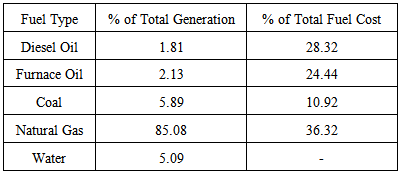 |
| |
|
Based upon the preliminary study of the Power System Master Plan (PSMP)-2010, the anticipated peak demand would be about 10,283 MW in FY 2015, 17,304 MW in FY2020 and 25,199 MW in 2025. The policy envisions 800MW of power from renewable energy by 2015 and 200MW of power by 2020. According to PSMP- 2010 Study year-wise peak demand forecast is shown in Table 6.Table 6. Year wise peak Demand Forecast
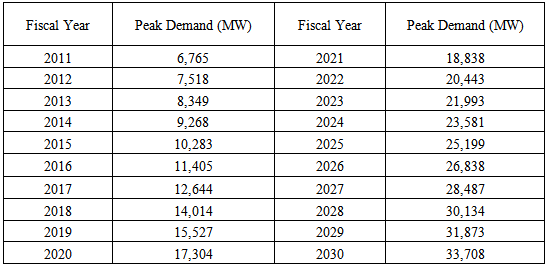 |
| |
|
3. Transmission and Distribution
The only company that works for the transmission of electricity in Bangladesh is the Power Grid Company of Bangladesh Ltd. (PGCB). As of June 2013, there is almost 3,020 km of 230 kV and 6,148 km of 132 kV transmission line available in the country. The number of 230/132 kV substations is 16 and combined capacity of those entire substations is 7,525 MVA. Besides, there are 103 substations of 132/33 kV available throughout the country with a capacity of 11,792 MVA. The distribution network is the biggest of the lot, with 3,728 km, 13,128 km and 21,839 km of 33 kV, 11 kV and 400 V lines, respectively. There are 158 substations of 33/11 kV for distribution of power around the country [3].Four companies are distributing the generated power along with BPDB. BPDB is responsible for distribution of electricity in most of the urban areas in Bangladesh except Dhaka Metropolitan City and its adjoining areas under DESA and DESCO, areas under West Zone Power Distribution Company Limited (WZPDCL) and some of the rural areas under Rural Electrification Board (REB). The Distribution Zones of BPDB are Chittagong, Comilla, Sylhet, Mymenshing, Rajshahi, Rangpur. 40.10% of the said generated power is purchased by Rural Electrification Board (REB) and distributed to the pastoral area. BPDB distributes 24.64% of the power among the urban consumers. Dhaka Power Distribution Company (DPDC) and Dhaka Electric Supply Company (DESCO) distribute 18.59% and 10.51%, respectively of the power among the consumers in Dhaka metropolitan area. The rest 6.17% of the power is distributed by West Zone Power Distribution Company (WZPDC) in Khulna and Barisal divisions. 46.52% of the power is used for resident loads, 10.34% for commercial purposes, 37.42% for industries, 3.17% for agriculture and 2.56% for other purposes. The share of electricity distribution by the relevant authorities has been shown in Table 7.Table 7. Share of Electricity Distribution by the Authorities
 |
| |
|
Among the distribution authority, REB has the highest share of electricity distribution. REB is working through Palli Bidyut Samiti (PBS) working over the country. The customer density of PBS is around 35. The urban areas are denser than rural areas. Figure 2 represents the customer density at different districts.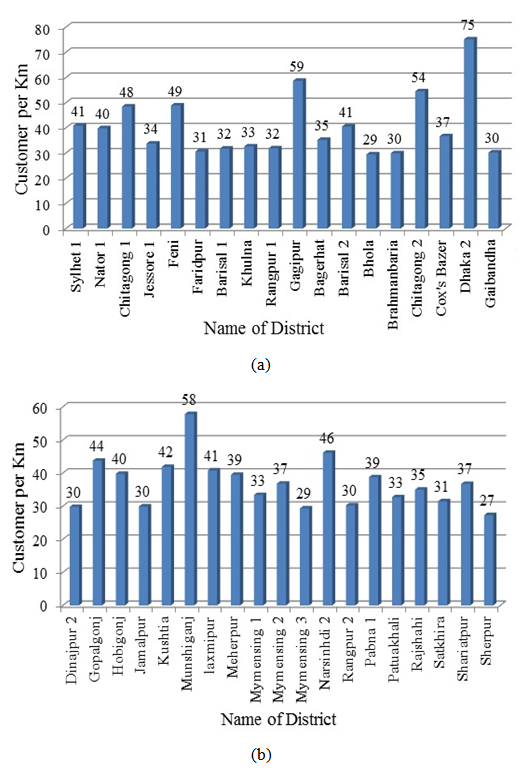 | Figure 2. Customer density of PBS in different districts of Bangladesh |
The summary of the length of transmission and distribution lines at various levels is given below:● 230KV: 1324.40 km route and 3020 ckt km (used conductor: Mallard, twin mallard, Twin AAAC, finch, ACSR● 132KV: 3505 km, 6148 ckt km (used conductor: Grosbeak, AAAC, HAWK, XLPE, Twin AAAC● 33KV feeder length: 3728 km● 11KV feeder length: 13128 km● 415 V feeder length: 21839 km
4. Local Mini-Grids
There are a number of local grids in the remote areas of Bangladesh. Most of the local grids in Bangladesh are run by diesel generators. Remote villages and markets have local grids. However, the electricity is available only for a few hours, and used mainly for lighting purposes only. Most of the grids have a generation scale of 5~10kW diesel generators serving about 20~50 number of customers/shops. These grids may be defined as mini grid or micro grid. In a microgrid, no transmission line is needed, only low voltage distribution lines are necessary. Here, bamboo poles or other supporting elements are used instead of the standard poles. The generation cost is around 30Tk per kWh. However, a customer is charged around 50Tk. per kWh.Besides these, solar PV based mini-grid projects are installed in remote areas of the country, where possibility of grid expansion is remote in the near future. These projects provide grid quality electricity to households and small commercial users, and thereby encourage commercial activities in the project areas.So far, IDCOL has financed one 100 kWp solar microgrid project in Sandwip Island. The project is currently supplying electricity to adjacent 250 shops, 5 health centers and 5 schools. Another four projects of different capacity (100~159 kWp) have been approved by IDCOL which are in various stages of construction. IDCOL has a target to finance 50 such solar mini-grid projects by 2017.
5. Complete Stand-Alone System
A complete stand-alone system has no distribution system. The generated electricity is sent to the load directly or via a storage device. Such an application is solar home system (SHS).At present, total 47 Partner Organizations (PO) are implementing the program under the supervision of IDCOL. More than 3 million SHSs have already been installed under the program in the off-grid rural areas of Bangladesh. As a result, 13 million beneficiaries are getting solar electricity, which is around 10% of the total population of Bangladesh. More than 65,000 SHSs are now being installed every month under the program. IDCOL has a target to finance 6 million SHSs by 2017, with an estimated generation capacity of 220 MW of electricity.Solar Photo Voltaic (PV) is used to convert the energy of sunlight into electrical energy. The unit is named as solar cell, it is a junction made from the p-type and n-type semiconductor (silicon). Incident light ray with certain wavelength will emit electron from the junction producing flow of electron or electric current. Several cells will form a solar panel/module and several panels/modules will form a solar array.The electricity generated from the sunlight by the solar PV panel could be utilized in several ways. Due to some limitation, this energy cannot always be used directly to the load. At night the production is zero and at foggy, cloudy or rainy day the output is very low. This is called intermittent source [10]. Due to the intermittency, output of the panel is not constant; it just fluctuates. This fluctuation may hamper the load and may even damage it. Most of the application needs battery as a backup to solve the problem of intermittency except the solar irrigation system, solar PV based battery charging station, grid tie system etc. For a larger system other resources may be used. Solar Home System (SHS) is remarkable among the application of solar PV. Conventional SHS have light bulbs as load that runs at night. In some cases, low power DC fan and TV are also used. The only way to use this electricity at night is to store the energy in a battery. Therefore, in this system battery is mandatory. Storing the electricity produced by the panel into the battery is known as charging and using the storage energy from the battery by the load is known as discharging. The length of duration while the battery can store and deliver the energy to the load properly is defined as the life time of the battery. It is specified by the number of cycle it is charged and discharged as well as years of operation. If the charging and the discharging are not taken place properly, the life time of the battery will be decreased. Too much charging or discharging is bad for the battery. To ensure this operation properly a charge controller is used. It may be compared to the brain of the total system. It will protect the battery, panel and the load from current reversal, overcharging, deep discharging, short-circuit and other bad impacts. The complete process is shown in the block diagram of Figure 3.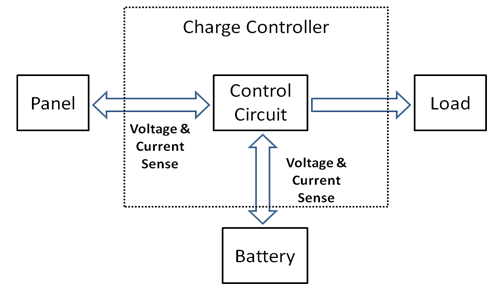 | Figure 3. Block diagram of a Solar Home System (SHS) |
6. Possibilities of Micro-Grid
As discussed earlier, a conventional power system consists of large-scale power stations, transmission lines, substations and distribution lines etc., where the generation and consumption of power are not at the same location. Remote areas are normally not connected with the electrical grid, thus these areas are deprived of development. On the other hand, SHS is being used drastically at the remote areas. Although the number of installed SHS unit is high enough, the total amount of electricity produced by these is not significant yet. Moreover, this is not a permanent solution of electricity. In this context, a local grid may offer a better alternative. Government has planned to install several microgrids at some selected region to add more power in the national generation from the renewable energy sector. Also, the Government has a plan to replace 19,000 number of diesel pumps with the solar PV system as well as installing some mini-grids at various remote sites [13-16].Owing to some important factors as will be discussed next, it is a high time to think of the higher penetration of renewable energy into the generation of electricity in a decentralized manner as proposed. For the traditional power generation systems, fuel cost for oil-based plants is high and sometimes it exceeds 30Tk per KWh [17]. The generation cost of natural gas based electricity is lower but, the reserve of our natural gas is going to be diminished very soon. Shortfall of generation due to shortage of enough supply of natural gas is common for generation [2]. Besides these, most of the generation units emit high amount of CO2 which increases the greenhouse effect and the global warming. In addition, the cost and loss associated with the evacuation system is not negligible either. Moreover, interruption at any node in the grid turns into load shading and hampers a lot of users, when many customers get completely disconnected from the grid.If the generation units (diesel generator) of local grids could be replaced by the solar PV, and these grids could be interconnected to some extent, the problem of electrifying the remote areas may be solved in a greater degree [18]. For example, a 10MW capacity power station may be replaced by installing 1000 number of generating units with 10KW capacity each, which are situated at different locations through an interconnected gird. It would not require any transmission network; rather a low voltage distribution network may be used for the distributed generation.Similarly, if the outputs of each PV panels are interconnected locally, then it would be able to provide the required energy, sufficient for all the users of the locality, by means of a microgrid [13], [16]. Microgrid is a group of interconnected loads and distributed energy resources (DERs) within clearly defined electrical boundaries that acts as a single controllable entity with respect to the grid [16-18]. A microgrid can connect and disconnect from the grid to enable it to operate both in grid-connected or in island-mode [13]. The available renewable energy sources in Bangladesh may be used as DERs in a microgrid, which will reduce the control burden on the grid and may meet a significant proportion of the national demand of electricity with a competitive price compared to the traditional power plants. The penetration of DER based microgrid is increasing in the developing country day by day. Moreover, a microgrid can be interconnected to any adjacent microgrid in case of emergency. Interconnected microgrids have more opportunities to share generated power among various loads and make it easier for load management and control. With proper design and implementation, interconnected microgrids have ample scope to be connected with the national grid without the need of installing new transmission lines [16].
7. Conclusions
Considering the possibilities of incorporating electrical microgrids, new models for generation and distribution of electricity should be in the agenda of power planning cell of the Government of Bangladesh. It is expected that by incorporating electrical microgrid by means of renewable energy, T&D loss and overall cost of electricity production will be minimized significantly. Also, the emission of CO2 will be negligible with a new load management technique as well as reliable and high quality power will be ensured within the shortest possible time. Installation of large power plant based on renewable energy resources is good. However, the scope of implementation is not available everywhere in Bangladesh. Moreover, it also needs the evacuation system, which is still costly even though loss has been minimized. On the other hand, the installed number of SHSs in the country is huge (more than 3 million) but its share to the total generation is not that significant. Moreover, it is not contributing to the national grid in any way. Therefore, proper sizing of the power sources are important as well as the evacuation system. New model with proper policy should be proposed as an alternative to the bulk scale generation and supplement the traditional power system.
ACKNOWLEDGEMENTS
The authors would like to acknowledge their gratitude to Bangladesh Power Development Board (BPDB), Power Grid Company of Bangladesh (PGCB) Ltd, Rural Electrification Board (REB) and Infrastructure Development Company Ltd. (IDCOL) for their data support.
References
| [1] | Annual Report 2012-2013, Bangladesh Power Development Board (BPDB), Dhaka, Bangladesh. |
| [2] | Daily Generation Report 2014, Bangladesh Power Development Board (BPDB), Dhaka, Bangladesh. |
| [3] | Annual Report 2012-2013, Power Grid Company of Bangladesh (PGCB) Ltd., Dhaka, Bangladesh. |
| [4] | Annual Report 2010-2011, Power Grid Company of Bangladesh (PGCB) Ltd., Dhaka, Bangladesh. |
| [5] | Monthly Operational Report 2014, Power Grid Company of Bangladesh (PGCB) Ltd., Dhaka, Bangladesh. |
| [6] | Annual Report 2012-2013, Infrastructure Development Company Ltd. (IDCOL), Dhaka, Bangladesh. |
| [7] | Annual Report 2010-2011, Infrastructure Development Company Ltd. (IDCOL), Dhaka, Bangladesh. |
| [8] | MIS Report 2013-2014, Bangladesh Rural Electrification Board (BREB), Dhaka, Bangladesh. |
| [9] | Monthly Operational Data 2008-2014, Dhaka Power Distribution Company (DPDC) Ltd., Dhaka, Bangladesh. |
| [10] | Annual Report 2011-2012, Dhaka Power Distribution Company (DPDC) Ltd., Dhaka, Bangladesh. |
| [11] | Monthly Operational Data 2011-2014, Dhaka Electricity Supply Company (DESCO) Ltd., Dhaka, Bangladesh. |
| [12] | Annual Report 2014, Dhaka Electricity Supply Company (DESCO) Ltd., Dhaka, Bangladesh. |
| [13] | R.H. Lasseter, “MicroGrids”, IEEE Power Engineering Society Winter Meeting, vol. 1, pp. 305-308, 2002. |
| [14] | M.S. Islam, A. Islam and E. Basher, “A self sufficient energy model for poultry firms in Bangladesh to reduce Greenhouse gas emission and increase energy efficiency”, 3rd International Conference on the Developments in Renewable Energy Technology (ICDRET), pp. 1-6, May 2014, Bangladesh. |
| [15] | A. Islam, M.S. Islam, M.M. Hasan, and A.H. Khan “Analysis of Wind Characteristics and Wind Energy Potential in Coastal Area of Bangladesh: Case Study-Cox’s Bazar,” ELEKTRIKA, vol. 15, no. 2, pp. 1-10, May 2014. |
| [16] | N. Hatziargyriou, H. Asano, R. Iravani, and C. Marnay, “Microgrids” IEEE Power and Energy Magazine, vol. 5 , issue 4, pp. 78 – 94, July-August 2007. |
| [17] | S. Krauter and F. Ochs, “The integrated solar home system”, 3rd World Conference on Photovoltaic Energy Conversion, pp. 2333-2336, May 2003, Japan. |
| [18] | L.L. Grigsby, Power System Stability and Control. CRC Press, Taylor & Francis, London, 2006. |




 Abstract
Abstract Reference
Reference Full-Text PDF
Full-Text PDF Full-text HTML
Full-text HTML





